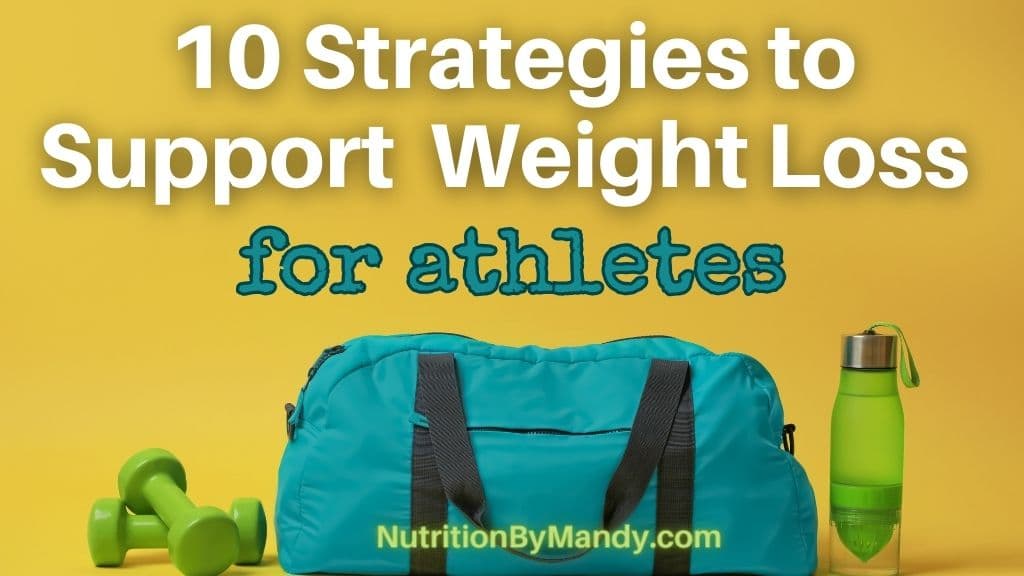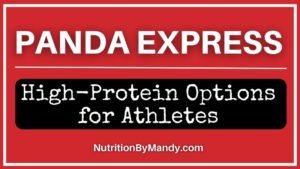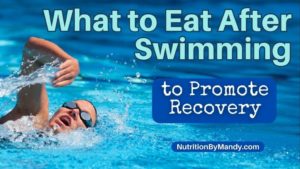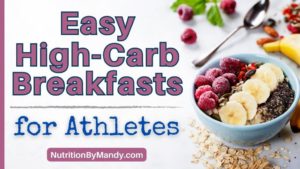10 Strategies to Support Weight Loss for Athletes
It can be challenging for athletes to know what steps to take when they desire to lose weight. With so much information available on different weight loss plans, it is easy to feel at a loss.
Let’s look at 10 strategies to support weight loss for athletes.
#1 Weight Loss for Athletes: Focus on the Off-Season
When possible, the best time for athletes to focus on changes in body composition is during the off-season.
During the off-season athletes have time to focus on sustainable changes to their diets. Over time these changes can result in gradual weight loss.
Although it can be tempting to try fad diets promising quick weight loss, these diets are often hard to maintain over the long-term. Many diets restrict food groups and key nutrients that are necessary for both health and sports performance.
In addition, the diets may result in the loss of lean muscle mass, which is not the desired outcome for athletes.
For this reason, when athletes desire to lose weight, it is best to monitor changes in body composition, with the goal of decreasing body fat and maintaining lean mass.

#2 Make Performance Nutrition a Priority
It is important for athletes desiring to lose weight to continue focusing on their performance nutrition needs. Athletes should not sacrifice their pre-, during, and post-event nutrition strategies in an effort to cut calories.
If athletes want to train and perform at their best, it is important to fuel appropriately.
This includes:
- Going into workouts optimally fueled
- Replacing fluid, electrolytes, and carbohydrates during activity
- Focusing on recovery nutrition following a workout
#3 Protein to Support Weight Loss for Athletes
When an athlete is reducing calories to lose weight it is important to increase protein intake.
The higher protein intake can help preserve lean muscle mass during the period of caloric restriction. This is particularly advantageous when the elevated protein intake is combined with a resistance training program (1).
To get the most benefit from protein, athletes are encouraged to consume protein throughout the day (2). Thus, athletess should aim to include a source of lean protein with each of their meals and snacks.
Lean Protein Options for Athletes
There are numerous lean protein options that athletes can enjoy when focusing on weight loss.
Protein-rich items athletes can add to their meals and snacks include:
- Chicken, turkey, seafood, pork, lean cuts of red meat
- Eggs, hard-boiled eggs
- Low-fat milk, high-protein milk, Greek yogurt
- Deli meat: Turkey, chicken, roast beef, ham
- Reduced-fat sliced cheese, string cheese, cottage cheese
Plant-based sources of protein:
- Edamame, beans, lentils, hummus, quinoa
- Nuts, nut butters, seeds, seed butters (be mindful of portion sizes)
- Tofu, tempeh, seitan, soy milk
#4 Be Aware of What You Drink
Sugar-sweetened beverages can add many excess calories to an athlete’s day. The calories in sugary beverages are frequently referred to as empty calories.
Empty calories provide energy, but lack other nutrients such as vitamins, minerals, and antioxidants. For example, a 12-oz soda contains ~150 calories and 40 grams of sugar, but lacks other nutrients such as vitamins, calcium, protein, or fiber.
Determining Sugar Content of Drinks
When you are selecting a drink, take time to look at the nutrition facts label to review the amount of sugar added to the drink.
As a point of reference, 1 teaspoon of sugar is equivalent to ~4 grams of sugar. If the drink contains 40 grams of sugar, that means it contains 10 teaspoons of sugar.

Drinks with High Sugar Contents
Drinks to be mindful of that typically contain large amounts of added sugar include:
- Soda
- Sweet tea
- Lemonade
- Fruit punch
- Slushies
- Frozen coffee drinks
#5 Watch Portion Sizes
One key strategy to support weight loss for athletes is watching portion sizes. Individuals are often unaware of how much they are consuming. When provided with a large serving it can be easy to unintentionally eat more than planned.
Although it is not necessary for athletes to weigh or measure everything they eat, having a general idea of what a serving size looks like can be of help. Try measuring out a serving of rice, pasta, or cereal to see what a normal serving looks like.
Moving forward use this mental image as a guide when placing a serving on your plate. Having this image in mind can be particularly helpful when dining out and portion sizes are often large.
Another way to help control portion sizes is to avoid eating food directly out of the bag or container. Portion out a serving of the item to enjoy, rather than mindlessly eating through the whole container.
#6 Look for Hidden Calories
Although individuals are often aware of what foods are high in calories, such as dessert items and fried foods, there are some high-calorie food items that may come as a surprise.
When athletes are working on weight loss, limiting calorie-dense foods can be of help. Calorie-dense foods are foods that contain a high number of calories compared to their weight.
Examples of calorie dense foods include:
- Salad dressing
- Mayonnaise
- Nuts and nut butters
- Seeds and seed butters
- Granola
- Avocados
Although many of these foods are nutritious and provide valuable nutrients, such as healthy fats, vitamins, and minerals, they also can add a lot of calories to your diet.
Athletes trying to lose weight can still incorporate these foods into their diet; the key is to be mindful about portion sizes.
#7 Choose Healthy Meal Prep Methods
Some cooking methods can add excess calories and saturated fat to your meal. When preparing food at home, choose healthy meal preparation methods.
Baking, grilling, steaming, and broiling are all great options for preparing your meals. Deep frying food in oil is a less healthy option.
Selecting Cooking Oils
Select oils for cooking that contain unsaturated fats, such as olive oil, safflower oil, sunflower oil, avocado oil, and canola oil. These oils contain less saturated fat making them a more nutritious option.
Cooking oils such as coconut oil and palm oil, as well as butter and lard, are high in saturated fat and less healthy options.
When you are cooking with oils, even those that are a good source of unsaturated fat, be mindful of the amount of oil you use in preparation. The use of cooking sprays are great options for use in meal preparation.
#8 Focus on Variety to Support Weight Loss for Athletes
When athletes are working to change their diets to promote weight loss, a key concept that is often overlooked is the importance of variety. Athletes should focus on eating a variety of healthy foods each day, including whole grains, fruits, vegetables, beans, lean protein, and dairy.

Avoid getting into a pattern of eating the same meals and snacks every day. Ideas for adding variety to your diet include:
Fruits
Athletes should choose a variety of colors and types of fruits to add to their meal plans. By selecting a variety of fruits, the athlete will consume an array of vitamins, minerals, antioxidants, and phytochemicals.
Purchase in season fruit, which is more flavorful and less expensive, than fruit that is out of season. The USDA has a Seasonal Produce Guide that can assist you with selecting seasonal fruits and vegetables to enjoy.
Vegetables
Similar to fruits, select an array of colors and types of vegetables to enjoy with your meals and snacks. Leafy greens, colorful bell peppers, summer squash, zucchini, cherry tomatoes, baby carrots, and cucumbers are all great options.
Keep frozen vegetables on hand to have as a quick side dish with a meal or to add into soups, pastas, and stir-fry meals.
Beans are a nutritious option, providing an excellent source of fiber and also protein. Keep a variety of beans on hands including: black beans, garbanzo beans, navy beans, lima beans, kidney beans, and soy beans.
Edamame (type of soybean) is a complete protein containing all of the essential amino acids. Edamame can be a great snack, topping on a salad, or high-protein, nutritious side item to enjoy with your meal.
Whole Grains
Athletes should focus on including whole grain carbohydrates in their sports nutrition meal plan. Whole grains provide fiber, vitamins, minerals, and antioxidants.
Select whole grain items such as quinoa, brown rice, oatmeal, and whole wheat bread, pastas, tortillas, and wraps.
#9 Select Healthy Snacks
Athletes should make healthy choices when selecting snacks for the day. Snacks are often associated with items such as candy, chips, and baked goods.
It can be helpful for athletes to change their perception of snacks and view them as an opportunity to provide your body with important nutrients needed to support your sports nutrition goals.
One way to do this is to focus on how you build your snacks. Aim for each snack to include a source of lean protein plus a healthy option from one other food group.
Example healthy snack ideas for athletes include:
- Low-fat string cheese + apple
- Greek yogurt dip + mini sweet peppers
- Turkey jerky + fresh berries
- Hummus + whole grain crackers
- Edamame + grapes
You can find additional ideas and tips for packing snacks in my blog Healthy Snacks for Teenage Athletes.

#10 Make Healthy Choices When Dining Out
Be mindful when dining out to make choices that are in line with your sports nutrition goals. The concepts discussed previously regarding sugar-sweetened beverages, portion sizes, and healthy cooking methods all apply to eating out.
Helpful Tips for Dining Out to Support Weight Loss for Athletes
When possible, select a restaurant that has healthy options available. Additional tips for dining out healthfully include:
- Request your sandwich be prepared on a whole grain bun.
- Top your sandwich, burger, or tacos with extra vegetable toppings.
- Choose healthy side items: Many restaurants now offer fruit cups, apple slices, side salads, and steamed vegetables as options with your meal.
- Select grilled, baked, or broiled options instead of fried items. Grilled chicken sandwiches, grilled chicken nuggets, grilled fish tacos, grilled beef or chicken fajitas, or a single patty burger are all leaner options that can fit within your sports nutrition plan.
- Request the sauce be served on the side: This includes mayonnaise, tartar sauce, salad dressing, and any other special sauces the restaurant offers. When the sauce is on the side you can have control over the amount added to your meal.
- Avoid supersizing: Rather than supersizing, enjoy a regular meal and eat a balanced snack later on if hungry.
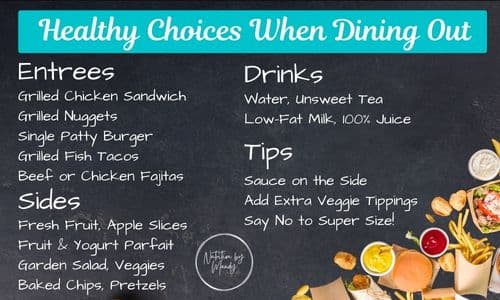
Supporting Athletes with Weight Loss Goals
It is important for athletes to avoid drastic cuts in calories and severe energy restriction when attempting to lose weight. Underfueling can be harmful to both an athlete’s health and performance.
Athletes should consider meeting with a sports dietitian nutritionist if they desire to change your body composition or lose weight. A sports dietitian nutritionist can assist the athlete with developing a customized meal plan to help them achieve their sports nutrition goals.
10 Strategies to Support Weight Loss for Athletes
You are now set with 10 strategies to support athletes with achieving their weight loss goals. As a reminder, it is best for athletes to focus on sustainable changes to their dietary patterns during the off-season, which can lead to long-term success.
For additional sports nutrition tips for athletes, check out my blog Meal Prep for Athletes: 5 Easy Steps to Success.
Join the Nutrition By Mandy Email List & Get a Free Weekly Meal Planner Template
Click HERE to join the Nutrition By Mandy e-mail list. When you join you will receive a free weekly meal planner template to download and plan out your meals for the week.
About the Author
Mandy is a Sports Dietitian Nutritionist in the San Antonio, TX area. She is a Registered and Licensed Dietitian, a Board-Certified Specialist in Sports Dietetics, a Licensed Athletic Trainer, and is a Certified Exercise Physiologist through the American College of Sports Medicine. Mandy has experience working with athletes at the high school, collegiate, and professional levels. She believes the key to reaching one’s full potential, both in everyday life and in sports performance, relies on a healthy nutritional foundation. Learn more about the work Mandy does here.

